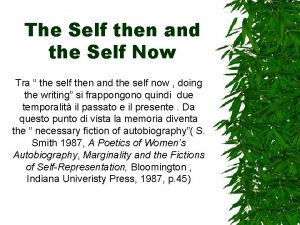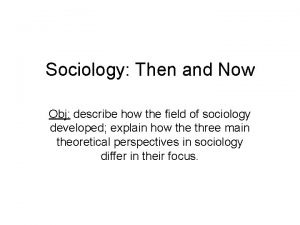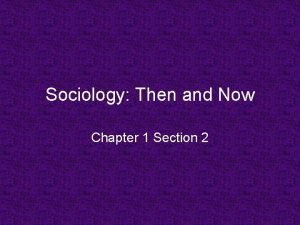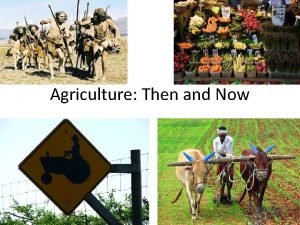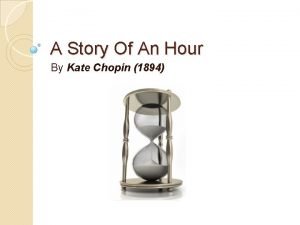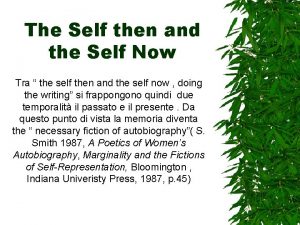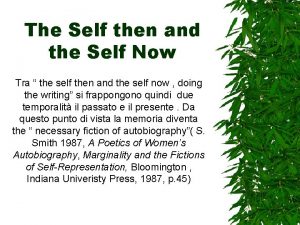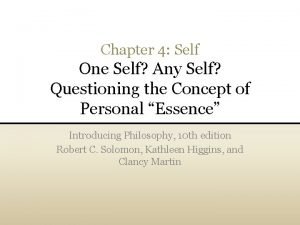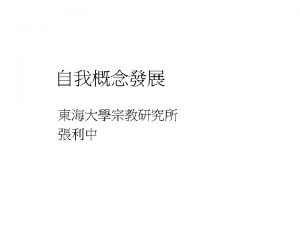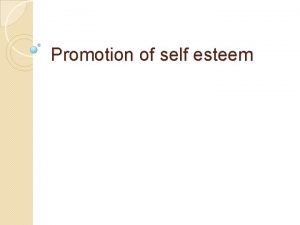The Self then and the Self Now Tra























- Slides: 23

The Self then and the Self Now Tra “ the self then and the self now , doing the writing” si frappongono quindi due temporalità il passato e il presente. Da questo punto di vista la memoria diventa the “ necessary fiction of autobiography”( S. Smith 1987, A Poetics of Women’s Autobiography, Marginality and the Fictions of Self-Representation, Bloomington , Indiana Univeristy Press, 1987, p. 45)


Autobiography in the Perspective of Feminist lierary Criticism Feminism and Autobiography , Texts , Theories , Methods, ed. by Tess Cosslett, Celia Lury and Penny Summerfield. London, Routledge and Kegan , 2000 Linda Anderson, “Autobiography and the Feminist Subject in Feminist Literary Tradition , Cambridge University Press, 2006.

Memory Studies and Gender Studies Studi di genere e memoria culturale, Women and Cultural Memory, edt. by V. Fortunati, G. Golinelli, R. Monticelli, Bologna, CLUEB, 2004, Memoria/ Memorie , Percorsi Transdisciplinari a cura di E. Agazzio e V. Fortunati, Roma, Meltemi, 2007.

The Work of Memory . “ Memory. . . has its own modes of expression: these are characterized by the fragmentary , non-linear quality of moments recalled out of time”(A. Kuhn, Family Secrets: Acts of Memory and Imagination, London and New York, Verso, 1995, p. 8)

Individual Memory and Collective Memory Nancy K. Miller l’autobiografia diventa per le donne un mezzo per raccontare attraverso la propria esistenza anche la storia del femminismo o comunque la storia della propria generazione di donna. In Getting Personal ( New York and London, Routledge, 1991 ).

The Concept of Intersubjectivity “ Intersubjectivity” “ the ways in which all the selves are structured by interactions with the others , and to a more general attention to the ways in which the self is framed and created by the social “.

Confession and Remembrance : Susannah Radstone “ Autobiographical Times” in Feminism and Autobiography , Texts , Theories , Methods, ed. by Tess Cosslett, Celia Lury and Penny Summerfield. London, Routledge and Kegan , 2000.

The Difference between Confession and Remembrance In confessional writing it is memory that arguably sutures over the break between the writing I and the I that is written about , in remembrance it is memory’s relation to subjectivity coherence that comes under scrutiny. Instead of suturing the division between the writing” I” and the ”I” that is written about, texts of remembrance tend rather to undermine the resilience of that suture, by emphasizing memory’s tenous relation to the past” ( S. Radstone, p. 205).

The Difference between Confession and Remembrance Inoltre si può anche aggiungere che mentre nella scrittura confessionale si tende alla ricerca della verità , nella scrittura come testimonianza, come è stato messo in luce soprattutto per la testimonianza di fatti traumatici, viene sottolineata la difficoltà di pervenire ad una forma di verità che abbia un valore assoluto. S. Felman and D. Laub, Testimony Crisis of Witnessing in literature , Psychoanalysis and Literature, new York and London, Routledge, 1992 hanno sottolineato that there is a move from one dimensional interpretation of truth, Both writers emphasize that testimony is an occurrence in the present , to do with the meaning of the past now and facilitated by specific situations and interchanges.

My four cases Simone de Beauvoir Doris Lessing Rosana Rossanda Baby Boomers

Simone de Beauvoir Mèmoirés d’une jeune fille rangèe( 1958) Memoirs of a Dutiful Daughter, La Force de l’ăge( 1960), The Prime of Life La force des choses( 1963)Force of Circumstance. Tout compte fait ( 1972) All Said and Done,

Leah Hewitt. Autobiographical Tightropes. Simone de Beauvoir, Nathalie Sarraute, Marguerite Duras, Monique Wittig, and Maryse Condé. Lincoln: University of Nebraska Press, 1990) . “Lurking in the interstices of de Beauvoir’s texts is the unresolved( and perhaps unresolvable) question of how the feminine subject chooses( creates ) her gender becomes a woman , within the framework of received social constructs that traverse all subjects. ”

Judith Butler and the construction of Gender “ It is an impulsive yet mindful process of interpreting a cultural reality laden with sanctions , taboos and prescriptions…rather than a radical act of creation , gender is a tacit project to renew one’s cultural history in one’s own terms”

Simone de Beauvoir. Dexieume Sexe In questo senso anche le autobiografie della de Beauvoir mettono in scena l’importante concetto che essa esprime in Dexieume Sex che donna non si nasce “ one is not born a woman”, ma che donna si diventa. Così nelle biografie di Simone si assiste non solo al suo diventare donna attraverso la dolorosa lotta che fin da giovanissima ingaggiò con il soffocante ambiente borghese in cui viveva e ma anche alla sua volontà di indipendenza maturata attraverso la sua formazione culturale.

De Beauvoir’s texts are illustrative of this tension in the way they move in and out “ literature” and “ experience”, continually transgressing the neat boundaries between genres , and confusing the distinction between remembering and creating.

The autobiographer has to be like a policeman writing his report: accuracy is paramount” Ma altre volte invece la scrittrice prefigura la scrittura autobiografica come una finzione creativa la cui verità sfugge ai disegni prestabiliti dell’autrice. In un intervista del 1960 a Francis Jeanson essa afferma che : “ there is no truth anterior to the one language expresses”. Inoltre nella sua ultima autobiografia All Said and Done essa dichiara molto esplicitamente che l’io creato in un’opera autobiografica è necessariamente una costruzione finzionale che non corrisponde mai interamente alla persona in carne ossa.

Doris Lessing “ Real remembering is-even if for a flash, even a moment-being back in the experience itself. You remember pain with pain, love with love, one’s real best self with one’s best self” ( Doris Lessing, Under my Skin, op. cit. , p. 218

Doris Lessing “I could with equal truth say I spent my childhood, girlhood and youth in the world of books. Or, wondering about in the bush, listening, and watching what went on. Here we are at the core of the problem of memory. You remember with what you are at the time you are remembering”( Doris Lessing, Under my Skin, p. 185) Lo sguardo retrospettivo obbliga la scrittrice ad analizzarlo con nuovi occhi a trasformarlo e a plasmarlo in un modo del tutto nuovo. “ The main reason, the real one, why an autobiography must be untrue is the subjective experience of time. The book is written , chapter one to the end , in regular process through the years. Even if you go in for sleights of hand like flashbacks or Tristram Shandy, there is no way of conveying in words the difference between child time and grown- up time-and the different pace of time in different stages of an adult’s life” ( Doris Lessing, Under My Skin, London Harper Collins Publishers, 1994, p. 109)

Doris Lessing “ As you start to write at once the question begins to insist: Why do you remember this and not that? Why do you remember in every detail a whole week, month, more, of a long ago year, but then complete dark, a blank? How do you know that what you remember is more important than what you don’t ? …And then –and perhaps this is the worst deceiver of all-we make up our pasts. You can actually watch your mind doing it , taking a little fragment of fact and then spinning a tale out of it”( Doris Lessing , Under My Skin, cit, pp 12 -13) Inoltre la scrittrice si rende conto che la memoria opera in maniera differente nelle single persone e che ci possono essere memorie contrastanti di uno stesso episodio. “ This experience which was shocking to me , began my attempt to understand the extraordinary slippering of memory; before that, I had taken it for granted that people with the same experiences would remember the same things. ”.

Doris Lessing This experience which was shocking to me , began my attempt to understand the extraordinary slippering of memory; before that, I had taken it for granted that people with the same experiences would remember the same things

Doris Lessing “ Real remembering is-even if for a flash, even a momentbeing back in the experience itself. You remember pain with pain, love with love, one’s real best self with one’s best self” ( Doris Lessing, Under my Skin, op. cit. , p. 218 ). Ricordare è quindi immergersi una seconda volta anche per un attimo , in una esperienza; ricordare è riviverla , non tanto nei dettagli, ma nella percezione dell’atmosfera che la circondava. Riprodurre l’atmosfera di un evento , di un particolare momento storico in modo vivido ed efficace è per la scrittrice impresa ardua. “ It is hard to convey the flavour of this encounter, because the atmosfere of that time is utterly gone. This is always the difficulty, trying to record the past. Facts are easy: this and that happened; but of the context and atmosphere, much behaviour –facts-social and personal seems , simply, lunatic”( Doris Lessing , Walking in the shade, p. 286)

“ But behind all that friendly helpfulness was something else, the observer, and it is here I retreat to, to take refuge , when I think that my life will be public property and there is nothing I can do about it. You will never get access here, you can’t, this is the ultimate and inviolable privacy. They call it loneliness, that here is the place unsharable with anyone at all, ever, but it is all we have to fall back on. Me, I, this feeling of me. The observer, never to be touched, tasted, felt, seen, by anyone else. “ ( Doris Lessing, Walking in the Shade, cit, p. 20. ). Forse in queste parole vi è la spiegazione del motivo per cui Lessing conferisce ai suoi romanzi il potere di esprimere la verità in maniera più efficace rispetto alla biografia. ( 2 There is no doubt fiction makes a better job of the truth, Doris Lessing, Under my Skin, cit, p. 314) ) La narrativa è un mezzo più diretto , per dire la verità , quella che infastidisce , quella che fa vergognare , quella che ognuno di noi preferisce custodire dentro di se
 Nowtra
Nowtra Sociology then and now
Sociology then and now Sociology: then and now
Sociology: then and now Seaside now and then
Seaside now and then Seaside holidays in the past
Seaside holidays in the past Sarah e goode
Sarah e goode Dubai 1960 and now
Dubai 1960 and now Agriculture now and then
Agriculture now and then Child labor then vs now venn diagram
Child labor then vs now venn diagram Seaside then and now
Seaside then and now Dudley allen
Dudley allen Then and now grammar
Then and now grammar Ffa handbook scavenger hunt answers
Ffa handbook scavenger hunt answers Jerusalem then and now
Jerusalem then and now Seaside holidays then and now
Seaside holidays then and now Now and then board
Now and then board Greece then and now
Greece then and now What is ideal self example
What is ideal self example Now i see it now you don't
Now i see it now you don't That was then this is now summary
That was then this is now summary Free body and soul free
Free body and soul free Yesterday reported speech
Yesterday reported speech Then now
Then now What is sweetened then soured boiled then cooled
What is sweetened then soured boiled then cooled
